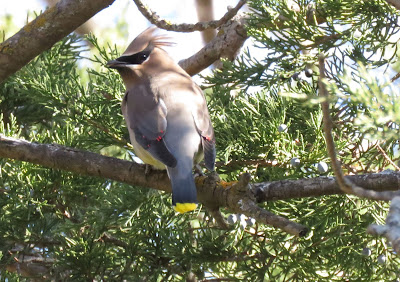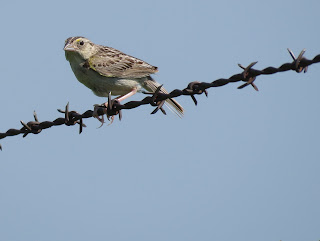This man made lake, made for fishing and boating, turns out to have enough habitat to be the best birding site in the state, just by a few birds. A larger lake (McConaughy/Ogallala) out West has just a few birds less. At Brached Oak in December and January you can see Bald Eagles.
The lake freezes for a short time but starts to melt in spring and we see more birds travel through from February on.
The levee on the East end offers views of what might be on the lake that day, such as masses of gulls or snow geese. Both ends of the levee have parking lots if you want to use a spotting scope. Going North you take the main entrance (it goes directly to the Marina (part of area 11) and has some indoor toilets part of the year) and you can get to these areas from the Marina to Area 10, mostly by gravel road:
Gulls and shore birds are here. Area 10 has some woods but is fenced off from time to time for grazing cattle in the North end. Area 10 far left parking lot gives views of gulls, ducks, mergansers, cormorants in that NW bay.
Going around the lake you can get to the Western half. Area 8 at the end of a gravel road has brushy areas. I've found Bell's Vireos in the bushes there every year. A sevice road goes North from Area 8, go on foot and avoid getting in private lands to the West. At area 8 some views of the same bay as from Area 10 are available.
Returning to Branched Oak Rd you can get to areas 5 and 6 and Lieber's Point which has offered good views of gulls, grebes and loons for me. It also gives views of ducks in the very middle of the lake. Birders often end up driving between Lieber's point and the Marrina to view the same bird in the middle.
On the South end there are three spots to view the lake. Multi-purpose trails (yes, horse poop found) give some woodland birds in May. You can start from a couple of parking lots just for hikers. Area 14 has a picnic shelter and you can walk fields in October to look for sparrows.
I happened to be doing the area Christmas count with another local birder and we had pretty good luck for December, with one hawk still to be assigned:
http://ebird.org/ebird/view/checklist/S41152848
Friday, December 1, 2017
Sunday, November 19, 2017
Target Birds
we birders use an online database for keeping lists. There is a smart phone app as well. See http://ebird.org/content/ebird/
I keep seeing the same birds over and over, and yet some rather common birds have become "nemesis birds". Such as purple finch. I have found the more difficult common redpoll, of birds that show up in winter. The solution is just to go to slightly wooded areas or find bird feeders to follow in winter. It was an easy bird every winter in Wisconsin.
My Lancaster county target list. The 19 and 20 slots are an owl and red shouldered hawk.
I keep seeing the same birds over and over, and yet some rather common birds have become "nemesis birds". Such as purple finch. I have found the more difficult common redpoll, of birds that show up in winter. The solution is just to go to slightly wooded areas or find bird feeders to follow in winter. It was an easy bird every winter in Wisconsin.
My Lancaster county target list. The 19 and 20 slots are an owl and red shouldered hawk.
Going state wide, a few fairly easy birds appear such as magpie. I have that from Colorado next door in my eBird list.
Wednesday, November 15, 2017
Winter is coming
An irruption is happening: red crossbills (above) have left their normal areas and are appearing South and East of it.
More waterfowl arrive, these for a month or two till the lakes freeze. A female bufflehead.
More waterfowl arrive, these for a month or two till the lakes freeze. A female bufflehead.
Some more winter birds: pine siskins:
Another female crossbill:
Harris's sparrows stay all winter:
A Western grebe:
And a few cormorants may stay as late as possible. They do not mind cold but do need to dive long distances for fish, so the whole lake needs to be ice free. It is drying its wings here.
Even a kingfisher. We have salty creeks where they can fish into December.
Saturday, October 7, 2017
Sunday, August 20, 2017
Friday, August 11, 2017
August shorebirds
August shorebirds that come through Eastern Nebraska seem to be fewer species than in the spring. Tht should make it easy to ID most. But there are more young birds among them.
These two were obviously least sandpipers:
But so was this:
There were tons of pectoral sandpipers at Tamora near Seward.
The yellow leg birds behind are Wilson's phalaropes
There was also one red-necked phalarope with a black smudge on the face and shorter bill. It also swims well and spins in the war.
Some birds look like they are working as a team or at least very tolerant of each other.
It's been hard to find anything without green or yellow legs, but here was the one semipalmated sandpiper at Jack Sinn (Killdeer for size comparison):
These two were obviously least sandpipers:
But so was this:
There were tons of pectoral sandpipers at Tamora near Seward.
The yellow leg birds behind are Wilson's phalaropes
There was also one red-necked phalarope with a black smudge on the face and shorter bill. It also swims well and spins in the war.
Some birds look like they are working as a team or at least very tolerant of each other.
It's been hard to find anything without green or yellow legs, but here was the one semipalmated sandpiper at Jack Sinn (Killdeer for size comparison):
Sunday, July 23, 2017
Home Stretch I Hope
Nest Boxes Blog
There are still a few boxes to follow. One just hatched two and the third will hatch today. I will be going to that box in a week and then a week later, with minimal work to check it. However, it is in very tall grass.
South Side
The nest box with with three fledged all three. There is one more box with 4 blue eggs. In a week I cans say if anything came of it.
Wrens have taken over several boxes, but only one has a nest.
With the sticks out the hole, it's a good guess it is just a male doing his duty, filling every cavity with sticks.
North Side
The four in Box 11 are ready to leave any day, fully feathered.
In Box 18, three eggs were laid and all 3 will hatch today, one still an egg.
There are still a few boxes to follow. One just hatched two and the third will hatch today. I will be going to that box in a week and then a week later, with minimal work to check it. However, it is in very tall grass.
South Side
The nest box with with three fledged all three. There is one more box with 4 blue eggs. In a week I cans say if anything came of it.
Wrens have taken over several boxes, but only one has a nest.
With the sticks out the hole, it's a good guess it is just a male doing his duty, filling every cavity with sticks.
North Side
The four in Box 11 are ready to leave any day, fully feathered.
In Box 18, three eggs were laid and all 3 will hatch today, one still an egg.
Wednesday, July 19, 2017
Subscribe to:
Comments (Atom)























































